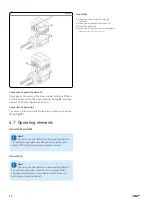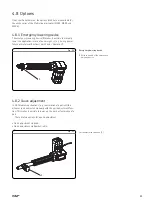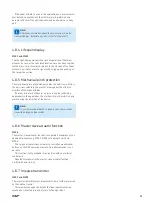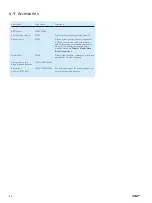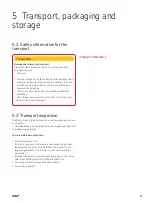
Table 8
Patient coupling port
Phenomenon
Basic EMC standard
Immunity test levels
Immunity test levels
Professional healtcare
Home healthcare
facility environment
environment
Electrostatic discharge
e)
IEC 61000-4-2
±8 kV contact
±2 kV, ±4 kV, ±8 kV, ±15 kV air
±8 kV contact
±2 kV, ±4 kV, ±8 kV, ±15 kV air
Conducted disturbances inducted
by RF field
a)
IEC 61000-4-6
3 V
b)
3 V
b)
0,15 MHz – 80 MHz
0,15 MHz – 80 MHz
6 V
b)
in ISM bands between
0,15 MHz and 80 MHz
6 V
b)
in ISM and amateur radio
bands between 0,15 MHz and 80 MHz
80% AM at 1 kHz
80% AM at 1 kHz
a)
The following apply:
– All patient-coupled cables shall be tested, either individually or bundled.
– Patient-coupled cables shall be tested using a current clamp unless a current clamp is not suitable. In cases were a current clamp is not suitable, an EM clamp shall be used.
– No intentional decoupling device shall be used between the injection point and the patient coupling point in any case.
– Testing may be perfomed at other modulation frequencies identified by the risk management process.
– Tubes that are intentionally filled with conductive liquids and intended to be connected to a patient shall be considered to be patient-coupled cables
– If the frequency stepping skips over an ISM or amateur radio band, as applicable, an additional test frequency shall be used int the ISM or amateur radio band. This applies to each
ISM and amateur radioband within the specified frequency range.
– The ISM (industrial, scientific and medical) bands between 0,15 and 80 MHZ are 6,765 to 6,795 MHz; 13,553 to 13,567 MHz; 26,957 to 27,283 MHz; and 40,66 to 40,70 MHz.
The amature radio bands between 0,15 and 80 MHz are 1,8 to 2,0 MHz; 3,5 to 4,0 MHz; 5,3 to 5,4 MHz; 7,0 to 7,3 MHz; 10,1 to 10,15 MHz; 14,0 to 14,2 MHz; 18,07 to 18,17 MHz;
21,0 to 21,4 MHz; 24,89 to 24,99 MHz; 28,0 to 29,7 MHz and 50,0 to 54,0 MHz.
b)
r.m.s., before modulation is applied.
c)
Discharges shall be applied with no connection to an artificial hand and no connection to patient simulation. Patient simulation may be connected after the test as needed in order to
verify basic safety and essential performance.
Table 9
Signal input/output parts port
Phenomenon
Basic EMC
standard
Immunity test levels
Immunity test levels
Professional healtcare
Home healthcare
facility environment
environment
Electrostatic discharge
e)
IEC 61000-4-2
±8 kV contact
±8 kV contact
±2 kV, ±4 kV, ±8 kV, ±15 kV air
±2 kV, ±4 kV, ±8 kV, ±15 kV air
Electrical fast
transients/bursts
b), f)
IEC 61000-4-4
±1 kV
±1 kV
100 kHz repetition frequency
100 kHz repetition frequency
Surges
Line-to-ground
a)
IEC 61000-4-5
±2 kV
±2 kV
Conducted disturbances
inducted by RF field
b),d), g)
IEC 61000-4-6
3 V
h)
3 V
h)
0,15 MHz – 80 MHz
0,15 MHz – 80 MHz
6 V
h)
in ISM bands between
0,15 MHz and 80 MHz
i)
6 V
h)
in ISM and amateur radio bands
between 0,15 MHz and 80 MHz
i)
80% AM at 1 kHz
c)
80% AM at 1 kHz
c)
a)
The test applies only to output lines intended to connect directly to outdoor cables.
b)
SIP/SOPS whose maximum cable lenght is less than 3 m are excluded.
c)
Testing may be performed at other modulation frequencies identified by the risk management process.
d)
Calibration for current injection clamps shall be performed in a 150
Ω
system.
e)
Connecters shall be tested per 8.3.2 and Table 4 of IEC 61000-4-2:2008. For insulated connectors shells, perform air discharge testing to the connecto shell and pins using the rounded tip finger
of the ESD generator. with the exception that the only connector pins that are tested are those that can be contacted or touched, under conditions of intended use, by the standard test finger
shown in Figure 6 of the general standard, applied in a bent or straight position.
f)
Capacitive coupling shall be used.
g)
If the frequency stepping skips over an ISM or amateur radio band, as applicable, an additional test frequency shall be used in the ISM or amateur radio band. This applies to each ISM and
amateur radio band within the specified frequency range.
h)
r.m.s., before modulation is applied.
i)
The ISM (industrial, scientific and medical) bands between 0,15 MHz and 80 MHz are 6,765 to 6,795 MHz; 13,553 to 13,567 MHz; 26,957 to 27,283 MHz; and 40,66 to 40,70 MHz.
The amateur radio bands between 0,15 and 80 MHz are 1,8 to 2,0 MHz; 3,5 to 4,0 MHz; 5,3 to 5,4 MHz; 7,0 to 7,3 MHz; 10,1 to 10,15 MHz; 14,0 to 14,2 MHz; 18,07 to 18,17 MHz;
21,0 to 21,4 MHz; 24,89 to 24,99 MHz; 28,0 to 29,7 MHz and 50,0 to 54,0 MHz.
22
Содержание Matrix MAX1
Страница 4: ...4 ...
Страница 87: ...Notes 87 ...























